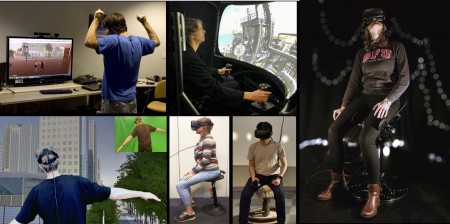
Siggraph 2018: 3D User Interfaces for Virtual Reality and Games: 3D Selection, Manipulation, and Spatial Navigation
3-hour Course Presented at Siggraph 2018
In this course, we will take a detailed look at different topics in the field of 3D user interfaces (3DUIs) for Virtual Reality and Gaming. With the advent of Augmented and Virtual Reality in numerous application areas, the need and interest in more effective interfaces becomes prevalent, among others driven forward by improved technologies, increasing application complexity and user experience requirements. Within this course, we highlight key issues in the design of diverse 3DUIs by looking closely into both simple and advanced 3D selection/manipulation and spatial navigation interface design topics. These topics are highly relevant, as they form the basis for most 3DUI-driven application, yet also can cause major issues (performance, usability, experience. motion sickness) when not designed properly as they can be difficult to handle. Within this course, we build on top of a general understanding of 3DUIs to discuss typical pitfalls by looking closely at theoretical and practical aspects of selection, manipulation, and navigation and highlight guidelines for their use.

3D user interface examples including gestures, bi-manual joystick, leaning (“human joystick”), and flying
Intended Audience
Developers, researchers, psychologists, and user-experience professionals who want to adopt new ways of interacting in Virtual Reality using state of the art 3D User interface design strategies, ranging from 3D selection and manipulation to spatial navigation.
Audience Takeaways
By participating in two consecutive and logically interlinked sessions, participants will acquire necessary skill set to design, develop and validate 3D interfaces and techniques for virtual reality and gaming systems. In summary, the sessions will enable participants to acquire the necessary knowledge and skills through covering spatial navigation and 3D selection/manipulation topics, grouped in the two blocks of the course.
With the increasing availability, quality, and affordability of immersive gaming and virtual/augmented/mixed reality hard– and software, there is an increasing need for improved interfaces that combine high usability and learnability with a more embodied interaction that goes beyond gamepads and mouse/keyboard approaches. This topic is highly relevant, as many application domains benefit from well-performing techniques, from games to 3D design exploration/review and big data exploration scenarios. Furthermore, due to the recent (re)advent of virtual reality, this area has become even more relevant as many users are affected by the (lack of) performance of 3D interfaces and techniques. Hence, we will cover the full range from hand-operated to full-body controlled interfaces, from low-cost to high-end.
Course structure
Both the selection and manipulation and the spatial navigation blocks deal with foundations and practical aspects to create a solid foundation for creating 3D user interfaces. While other 3D user interface tasks, such as system control, exist, navigation and selection/manipulation form the predominant tasks in most 3D user interfaces, and thus are highly representative.
Both the 3D Selection and Manipulation and the spatial navigation blocks will start by covering the fundamentals and applicable usage domains. This includes a classification of different interfaces and techniques (with pros and cons) as well as other issues including adverse effects such as motion sickness and usability issues will be discussed, along with a set of guidelines to alleviate them.
In the subsequent more applied practice section of each block, we will provide an overview of the methodologies to design, develop, and validate novel interfaces and interaction techniques, again accompanied with a set of guidelines. Attendees will also be guided through various real-world design examples that highlight the foundations and practical design decisions, development issues, and validation methodologies.
Speaker Biographies
Bernhard Riecke is associate professor in the School of Interactive Arts & Technology (SIAT) at Simon Fraser University. Riecke received his PhD from Tübingen University in 2003 and worked for a decade in the Virtual Reality group (Cyberneum) at the Max Planck Institute for Biological Cybernetics, as well as Vanderbilt and UC Santa Barbara. His work spans theoretical and applied domains and is published in journals including Frontiers, JOV, ACM-TAP, Cognition, and Presence, and conferences including IEEE VR, ACM-CHI, ACM SIGGRAPH, ACM-SUI, ISEA, and Spatial Cognition. Bernhard recently gave a TEDx talk on “Could Virtual Reality make us more Human”.
Joseph J. LaViola Jr. is an associate professor in the Department of Computer Science at the University of Central Florida. He directs the Interactive Computing Experiences Research Cluster of Excellence and is also an adjunct associate research professor in the Computer Science Department at Brown University. He is the lead author on the second edition of “3D User Interfaces: Theory and Practice”, the first comprehensive book on 3D user interfaces. Joseph received a Sc.M. in Computer Science in 2000, a Sc.M. in Applied Mathematics in 2001, and a Ph.D. in Computer Science in 2005 from Brown University.
Ernst Kruijff is interim professor at the Institute of Visual Computing, Bonn-Rhein-Sieg University of applied sciences and adjunct professor at Simon Fraser University. His work has been presented at conferences such as IEEE VR, 3DUI and ISMAR, and ACM VRST. Ernst has presented numerous courses about 3DUI topics, including ACM SIGGRAPH, CHI and VRST, and IEEE VR. Ernst is co-author of the standard reference in the field of 3DUIs (LaViola et al. 3D User Interfaces: Theory and Practice, 2017).
Supplementary materials
Some of the course concepts are based on the presenters’ book: Joseph J. LaViola Jr, Ernst Kruijff, Ryan P. McMahan, Doug Bowman, and Ivan P. Poupyrev. 2017. 3D User Interfaces: Theory and Practice (2nd ed.). Addison-Wesley.
Draft course notes and slides can be downloaded here. please cite as: Riecke, B. E., LaViola Jr., J. J., & Kruijff, E. (2018). 3D User Interfaces for Virtual Reality and Games: 3D Selection, Manipulation, and Spatial Navigation. In Proceedings of ACM SIGGRAPH 2018 Courses (SIGGRAPH ’18). (half-day course). Vancouver, BC, Canada
Videos for the navigation parts are directly linked in the .pdf slides. Videos of the 3D selection and manipulation parts are listed here: